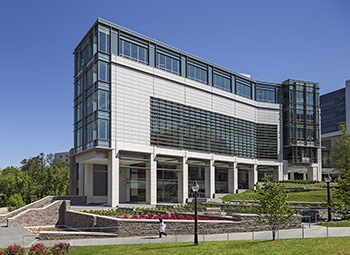 DURHAM, N.C. — Through early decision-making and focused goals, the Mary Duke Biddle Trent Semans Center has become the first building on the Duke University medical center campus to receive LEED Gold certification.
DURHAM, N.C. — Through early decision-making and focused goals, the Mary Duke Biddle Trent Semans Center has become the first building on the Duke University medical center campus to receive LEED Gold certification.
Designed by S/L/A/M Collaborative (SLAM), headquartered in Glastonbury, Conn., in collaboration with Duda Paine Architects of Durham, N.C., the 115,000-square-foot building was initially planned to achieve LEED Silver. However, by making decisions early, reminding the team of sustainable targets and reevaluating them at critical milestones, the $53 million building was granted 98 percent of the total attempted points for LEED Gold certification.
“It really doesn’t become a separate operation; it becomes part of the team dynamic,” said Ray Weaver, project manager with SLAM.
The six-story center is the first new medical building on the campus in 80 years. It is a modern, state-of-the-art medical education facility that mimics the joining hospital.
“We created simulation labs and clinical skill labs directly set up and oriented exactly the way the patient rooms are in the hospital next door,” Weaver said. “What the students are learning in is the exact same environment they will be performing in.”
To achieve LEED goals, it all begins with good planning, Weaver explained. Knowing what can be achieved based on the client’s expectations allows the firm to achieve their goals without much of a problem.
“We pretty much approach every project with eyes wide open. We take advantage of any sustainable component that we can,” Weaver said.
The building, which connects to the 924-bed Duke University Medical Center, features a pedestrian pathway surrounding the building to enhance the outdoor environment. The building hosts several outdoor study areas and the fourth floor contains an outdoor student lounge.
To further stress the connection to the outdoors, the glass-filled southern façade is situated as the front base of the medical campus, providing ample views and daylight. The southern façade incorporates horizontal light shelves while the western façade uses vertical fins, which reduces overheating and saves energy through reduced lighting loads. The amount of glass used in the long southern façade also creates a kind of activity zone, Weaver said.
“At night the building becomes sort of a glowing beacon of activity,” he said. “You’re able to visually connect from the outside into the building.”
For Greg Bergmiller, LEED AP, sustainable design coordinator with SLAM, his 11 years of experience as a LEED Accredited Professional has allowed him to increasingly identify opportunities for sustainability. For example, a terraced rain garden that captures stormwater run-off is both functional and a beautiful addition to the building.
“It’s an example of utilizing the stormwater design for not only dealing with stormwater but also a very beautiful and articulated space that people can use and coexist with it,” Bergmiller said.
While the rain garden helps to mitigate outflow, it also filters the water through natural filtration.
One simple but impactful design decision to achieve LEED points was the use of a white roofing membrane, Bergmiller said. Using the cool roofing membrane is especially important in warmer climates.
“If you’ve got a black roofing membrane up there, it can actually be 50 degrees hotter than what the ambient temperature of the day is,” he said. “By putting that cool roof membrane up there, you’re reducing that demand by an extra 40 to 50 degrees right away so that it’s pulling more air from the ambient temperature.”
The Mary Duke Biddle Trent Semans Center began welcoming students in February.

